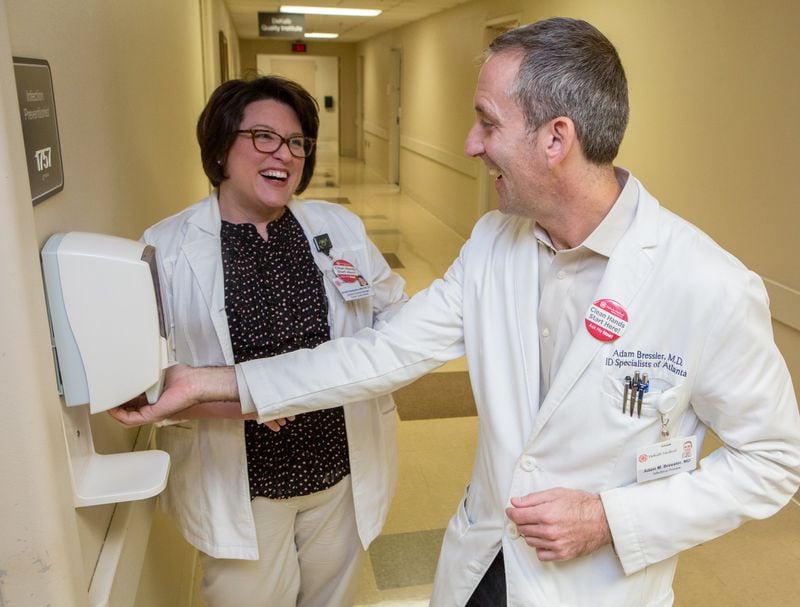The CDC says flu season continues to be on the rise. But even in a milder flu season, if you work outside the home, you're highly likely to pick up a bug at your workplace.
Part of that's because nearly 60 percent of employees go to work when they're sick, according to a 2013 study by workplace consulting firm Kimberly-Clark Professional reported by Business News Daily. Almost a third of the workers polled said they worked while sick because they are "too important to their business's operation to stay home."
So even though you're most likely to catch a bug from the close confines of the workplace, you can't count on light-hearted remarks like, "Hey, why don't we all just stay home when we're not feeling good! Netflix is great" to solve the problem. Instead, you have to control what you can, aka your own behavior, to protect yourself.
The process involves both workplace strategy and plain old good health habits. Here are nine ways to keep from catching the office bug when sick co-workers won't stay home:
Speak up. It may cost you a little pride, but workers should definitely ask HR or the building manager to provide "convenient and accessible tools" to help break the chain of germ transmission at the office or on the sales floor or assembly line, according to KCP. These items could include hand sanitizer, disinfecting wipe and facial tissues.
Wash your hands. Yep, the old kindergarten rule comes in to play, according to a Forbes round-up of tips from infectious disease experts. "When a sick colleague sneezes or coughs, you may come into contact with infected respiratory droplets," Forbes explained. "If you touch your eyes, mouth or nose with unwashed hands you could get sick."
Keep hand sanitizer handy. Forbes also reported research that found viruses can be transferred via light switches and telephones. Other hot spots for germ spread, according to Business News Daily, include elevator buttons, stair railings or ATM machines that have been contaminated by people who are ill. According to KCP, washing, wiping and sanitizing reduce your odds of catching the common cold or this year's flu strain by around 80 percent.
Make contact carefully. You can't stop a colleague from sneezing or coughing near you. But you can avoid situations that involve touching hands with contagious co-workers. You can always blame the request on your own (fictitious) health condition, "I would shake hands, but I'm afraid I'm a little under the weather." If you get trapped into shaking hands anyhow, wash your hands thoroughly or use quality hand sanitizer right afterwards. Sure, people might think you're a germaphobe, but it beats catching the office bug.
Cover up. This is another tactic for workers who value their health more than they worry about looking a little eccentric. According to Forbes, a person who sneezes can create a cloud of infected respiratory droplets that, assisted by a cough, can travel as far as four feet. If you're in the cubicle nearby, the infection can reach you easily. "While wearing a face mask at your desk to avoid inhaling a virus might be a little much, consider wearing a turtleneck or scarf and covering your nose and mouth during those prolonged coughing fits," Forbes noted.
Keep your hands off your face. This one is tough. But pathogens that you can get from touching contaminated surfaces or when contaminated people sneeze on you can enter your body via orifices, according to Natural News. "So if you keep on touching your eyes, nose, or mouth as you go along your workday, you may be headed for trouble," it added.
Hold your breath. If a sick person passes you and you can't walk away quickly, just stay where you are and hold your breath, NN recommended. Practice the technique ahead of time so it won't look so obvious and you won't have to worry about offending a co-worker while you keep bacteria or viruses from entering your body via the air you breathe.
Sneeze or cough properly. Seriously, there is a right way to do this that you should use yourself and also encourage co-workers to follow. If you don't have a tissue handy, cough or sneeze into the inner part of your sleeve (or arm) at the elbow, not your hand or the air, according to KCP.
Stay informed in case you have a chance to preach. You probably don't have the time or energy to challenge your workplace culture (especially if you end up getting sick!), but if the topic ever comes up, be sure you're up on "presenteeism," which is sick employees coming to work.
According to a study published in the Journal of Occupational and Environmental Medicine and reported by the Quick Books blog, "presenteeism" costs employers up to three times as much as absenteeism in terms of lost productivity.
About the Author






